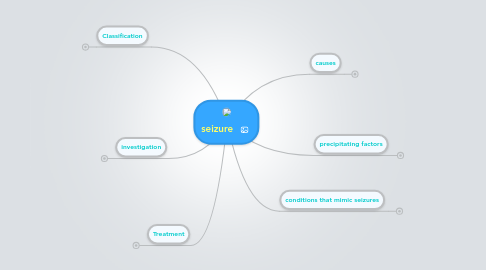
1. Classification
1.1. partial seizure
1.1.1. simple
1.1.1.1. motor, unimpaired consciousness, +/- aura
1.1.2. complex
1.1.2.1. motor, impaired consciousness, aura,
1.1.3. partial secondary
1.1.3.1. focal seizure followed by Generalised tonic-clonic seizure
1.2. Generalised seizure
1.2.1. absence
1.2.1.1. sudden cessation of motor activity, no loss of body tone, never have aura
1.2.2. tonic-clonic
1.2.2.1. tonic->clonic movement, loss if sphincter control, aura
1.2.3. atonic
1.2.3.1. loss of muscle tone causing sudden fall to the floor
1.2.4. tonic
1.2.4.1. generalised increase in tone
1.2.5. myclonic
1.2.5.1. sudden flextion of muscle group, jerking movements of limbs.neck,trunk
1.3. Febrile convulsion
1.3.1. 5 month - 5 years
1.3.2. Fever
1.3.3. Generallized 1 -10 min
1.3.4. post ictal state
1.3.5. exclude other causes
1.4. status epilepticus
1.4.1. definition
1.4.1.1. seizure > 30 mint w' no return of consciousness
1.4.2. causes
1.4.2.1. febrile seizure
1.4.2.2. idiopathic Ep. w' sudden withdrawal of anticonvulsant
1.4.2.3. symptomatic
1.4.2.3.1. structural anomalies
1.4.2.3.2. encephalitis. etc
1.4.2.3.3. metabolic cause
1.4.3. treatment
1.4.3.1. drug IV
1.4.3.1.1. diazepam; 0.1 - 0.3 mg/kg/dose (+3 dose)
1.4.3.1.2. lorazepam: 0.05 - 0.1 mg/kg
1.4.3.1.3. midazolam: 0.2 - 0.3 mg/kg
1.4.3.1.4. phenytoin 20mg/k/dose (+N.S)
1.4.3.1.5. phenobarbitone 20mg/k/dose (10 mint)
1.4.3.2. if no response (barbiturate coma)
1.4.3.2.1. General anesthesia (halothane)
1.4.4. investigation
1.4.4.1. CBC, electrolytes, Drug level, ABG. L.P, CT, EGG
1.4.5. examination
1.4.5.1. trauma
1.4.5.2. fontanel
1.4.5.3. sign of ICP
1.4.5.4. Retina
2. Treatment
2.1. anticonvulsant drug
2.1.1. Bendozodiazepines
2.1.1.1. Diazepam + Lorazepam
2.1.1.1.1. IV status Ep.
2.1.1.2. clonazepam + Nitrazepam
2.1.1.2.1. oral myoclnic Ep.
2.1.2. carbamazepine "tegretol"
2.1.2.1. partial & Generalized Ep.
2.1.3. Ethusuximide
2.1.3.1. Absenc Ep.
2.1.4. phenobarbitone "luminal"
2.1.4.1. Generalized Ep. & status Ep.
2.1.5. valproic acid "depakene"
2.1.5.1. Generalized Ep. & Absenc Ep. & myoclnic Ep.
2.1.6. ACTH
2.1.6.1. infantile spasm
2.1.7. Lamotrigine
2.1.7.1. complex partial & Generalized tonic-clonic
2.1.8. vigabantin
2.1.8.1. infantile spasm
2.1.9. Topamax
2.1.9.1. spectrum anticonvlsant
3. investigation
3.1. CBC
3.2. Bld sugar
3.3. Bld gases
3.4. electrolyte
3.5. Bld Ca
3.6. Bld Na
3.7. EGG
3.8. MRI scan
3.9. CT scan
3.10. LFT
3.11. Drug level
4. causes
4.1. Epilepsy
4.1.1. idiopathic (70-80%)
4.1.2. Secondary
4.1.2.1. Cerebral dysgenesis / malformation
4.1.2.2. Cerebral vascular occlusion
4.1.2.3. Cerebral damage
4.1.2.3.1. congenital infection
4.1.2.3.2. hypoxic-ischaemic encephalopathy
4.1.2.3.3. intraventricular haemorrhage
4.1.2.3.4. ischaemia
4.1.3. Cerebral tumour
4.1.4. Neurodegenerative disorder
4.1.5. Neurocutaneous syndromes
4.2. Non-epileptic
4.2.1. Febrile convulsions
4.2.2. Metabolic
4.2.2.1. Hypoglycaemia
4.2.2.2. Hypocalcaemia / hypomagnesaemia
4.2.2.3. Hypo / hypernatraemia
4.2.3. Head trauma
4.2.4. Meningitis / encephalitis
4.2.5. poisons / toxins
5. precipitating factors
5.1. Fever
5.2. Fatigue
5.3. Emotional stress
5.4. Drug e.g theophylline
6. conditions that mimic seizures
6.1. night terrors 1 -3 %
6.1.1. child screams
6.1.2. dilated pupil
6.1.3. amnesia
6.1.4. emotional
6.2. Breath holding attack
6.2.1. cyanotic
6.2.2. pallid
